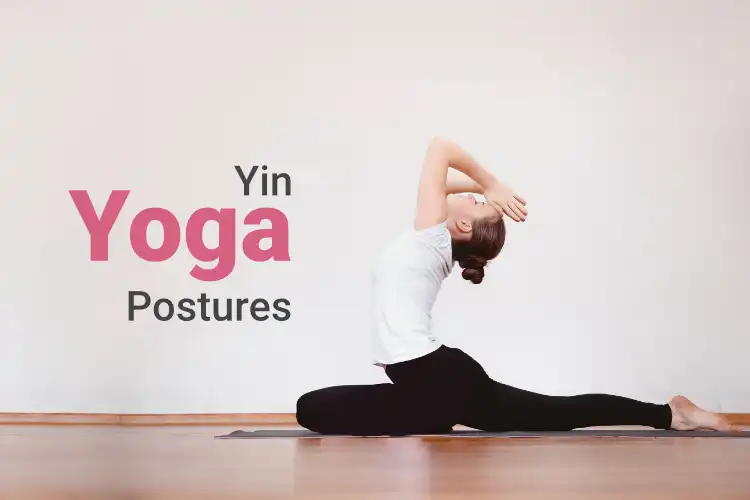Yin Yoga Posture

Yin yoga works on the principle of traditional chinese medicine with different types of asanas. The goals and objectives of Yin Yoga are the same as those of any other school of yoga; however, it directs the stimulation normally created in the asana portion of the practise deeper than the superficial or muscular tissues (which we call the yang tissues). Yin Yoga is aimed at connective tissues like ligaments, bones and also joints in the body that are not normally very actively practised in other asanas.
Yin Yoga is a passive practice that involves variations of seated and supine poses that are typically held for 3 to 5 minutes, allowing deeper layers of the outer skin to be accessed.
Can Beginners Practice Yin Yoga?
Yin Yoga is suitable for beginners. Beginners in yin yoga – don’t be concerned if you don’t feel open or flexible enough to practice—one of the reasons yogis practise Yin Yoga is to increase strength and flexibility in the body.
Due to the slower practice and longer duration of the postures, beginners can follow it more easily and faster than the vinyasa practice. However, it can also feel quite intense in your body, so give yourself plenty of time and space as you become acquainted with this yoga practice.
Types of Yin Yoga Postures
There are 26 types of Yin Yoga Postures. Principles of Yin Yogas are applied to every area of the body.
Below are the types of Yin Yoga and how to try the poses:
The Anahatasana or a melting heart, opens deeply the shoulders, chest, breast, spinal cord, neck and bottom of the back. To try this yoga, move forward on your hands and knees so that your chest falls to the ground. Keep the hips over your knees right. Try to keep the space between your hands shoulder width apart if possible. Treat the shoulders, neck, spine, chest, and lower back for 3-5 minutes. Hold thoroughly. Remember to always check where your attention is going, energy flows and it is important to stay focused in these more demanding Yin Yoga poses.
- Ankle Stretch
To try this: For many postures, including Toe Squat, regular Squats and sitting meditations, this can be a nice counterposition. To try this just start to sit on your heels. This may not be the pose for you if your ankles or knees complain (Beginners can seek advice from experts). - Bananasana
To try this: With your legs straight, lay on your back, while your arms or elbows overhead. Move your feet and upper body to the right with your buttocks firmly stuck to the earth. Like a lovely, ripe banana, Arch. Be sure that your hips are not twisted or rolling off the ground. Find your first surface. When you open more, move the feet to the right and pull the upper body to the right. Continue to play on this surface. Remember to do both sides! - Bridge
To try this: Begin to lie with bent knees on your back. Uplift the hips high enough to slide under the pelvis a block or bolster. Ensure that the support is provided to the pelvis and NOT to the bottom of the back. We do not want to support the lumbar spine. Do NOT put a block on your thin edge as it might be unstable and can be tipped while you are in the pose. Add additional blocks if additional height is needed. - Butterfly
To try this: Bring your feet together from a sitting position and slide them from you. Allow your back to go around, fold forward and hold your hands slightly in front of you or your feet. Your head should hang over to the heels - Half butterfly
To try this: Draw one foot from a seated position and straighten the other leg up to the side. Allow the back to round, fold to the centre of both legs. - Camel
To try this: You can sit on your heels, put your hands behind you on the ground and lift your hips forward. As the hips progress, your back arches. - Cat pulling its Tail
To try this: Begin by sitting in front of you with both legs. Turn right on your right elbow and recline. Keep your leg straight on (right), take your leg to and from the top (left). Bending your lower leg to your buttock, bringing this heel. Go back (left) with the top and grab the base foot. And then, slowly withdraw your foot. - Caterpillar
To try this: Place your feet on a cushion and extend your legs straight out in front of you. Allow your back to round as you fold forward over your legs. - Child’s Pose
To try this: Starting on your heels, slowly fold forward, bringing your chest to your thighs and your forehead to the ground. - Dangling
To try this: Place your feet hip-width apart and stand up. Fold forward with your knees bent. With the opposite hands, fasten the elbows. - Deer
To try this: Begin in Butterfly on the floor, then swing your right leg back behind you, bringing your foot behind your hip. Move your foot away from you to position the front leg. With your front knee, try to form a right angle. Drive your foot out of your hip until you feel like you are tipping away. Maintain a tight grip on both sitting bones. - Dragons
To try this: Start on your hands and knees or in Down Dog. Move one foot in front of the other. Continue on your front foot, until the knee is over the heel. Glide back as far as possible into the back knee. Maintain your hands on either side of your front foot. - Frog
To try this: Commence in Toddler’s Pose by sliding both hands forward, splitting the knees while remaining seated on the heels. Tadpole is another name for this. - Happy Baby
To try this: Touch your knees to your chest while lying on your back. Take your feet ‘ soles, ankles, or legs’ back. Step up your feet to the top of your knees and bring the knees around the chest towards the floor. Lower your head and shoulders to the floor. - Reclining Twists
To try this: Take both knees into your chest while lying on your back. Decline your knees to one side and open your arms to the side such as wings. - Saddle
To try this: There are many other ways to get into this position. Proceed by sitting on your heels and see what it feels like. If your knees hurt, don’t do this one. If ankles are hurting you, suggest putting a towel under them or avoiding the pose altogether. Bend down on your hands and make a small arch in your lower back. Keep an eye on how you’re feeling. Come on your elbows if you are able to do more. - Shavasana
To try this: To do Shavasana lie on the back with legs spread so broadly that they are out of your workout mat and arms are relaxed and your eyes shut. The entire body is relaxed on the floor and the chest and abdomen are noticed to rise and fall with every breath. - Shoelace
To try this: This pose is supported by several options. Starting on all fours, putting one knee behind another and laying back between the heels is one method. A second method is to sit on your heels and then go to a cheek and bring the external foot to the opposite hip. A third choice is to sit cross-legged and then draw one leg under the opposing thigh and the other over toward the opposing hip.
Don’t try to sit on your feet, but slide as much as possible. - Snail
To try this: Begin by lying down on your back. Raise your hips and use your hands to support them. Let your back be round, and let your feet fall on your head towards the floor, unlike the plough posture (Halasana), in which we try to keep the spine and legs right. Place your body’s weight on your shoulders; note how much weight is on your neck—a little is fine, but not too much! - Sphinx and Seal
To try this: Lay on your stomach. Grab your elbows with your opposite hands and move your elbows just ahead and stand up. Take note of how it feels in your lower back. If the sensations are too intense, move your elbows forward and lower your chest closer to the floor. You can mimic a sphinx by placing your palms flat on the floor in front of you. - Square
To try this: It can be a difficult thing to do. The main thing is to go where you can feel a bit of juiciness, never in the knees. Begin by sitting crossed with your legs. Step forward with your feet until your shins are parallel to the front edge of your mat (your legs are “square” to it).
Try to bring your knees closer together without allowing your feet to return to their original position. - Squat
To try this: Begin by placing your feet hip-width apart. Put your arms and hands in prayer and elbows pulling slightly against the knees or shines before you. Squat. - Straddle (aka Dragonfly)
To try this: Stretch your legs out of a sitting position until they go no further. You’ll help to tilt your hips sitting on a coil. Keep the arm straight or rest your elbows on the block, rest your weight into your hands. - Swan & Sleeping Swan
To try this: There are 2 ways to get into this pose either Down dog pose or cat pose. Glide your right knee between your hands, lean a little to your right, and see how you feel your right knee. Flip and move forward if the knee is good, and bring the foot closer to the right hip if the knee is stressed. Now focus so that your weight is even. Try to tuck the back of your toes and slip the back of your knee. Repeat this several times until your right buttock is on the floor or as low as it will go. - Toe Squat
To try this: Start by sitting with your feet on your heels. Pull the toes down and try to stand on the feet’s balls, not the tip-toes. Take the small toes down and tuck.
After performing the whole set of Yin Yoga, now let’s unveil the gamut of benefits that it brings for you.
Benefits of Yin Yoga
- Enhances your flexibility
- Enhances mind and body relaxation
- Reduces levels of stress and fear
- Improves circulation of the body
- Fascist releases
- Let your energy flow into your body easily.
- Enhances joint mobility and motion range
- Releases physical, emotional and body blocks.
Wrapping Up
Not only exists in the subcontinent of India but also prevails in the major eastern countries. Originating on the land of eastern world, Yin Yoga also provides a lot of benefits similar to our yoga practises. So, it is always good to get exposure to the other yoga forms that can help to unleash your potential along with improving your overall health.







